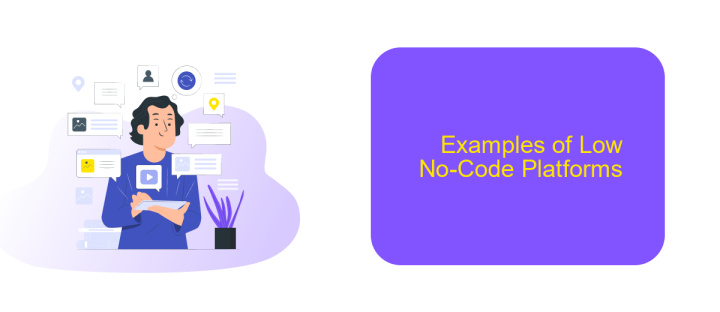Low No-Code Platforms
Low no-code platforms are revolutionizing the way businesses approach software development. By enabling users to create applications with minimal coding knowledge, these platforms empower non-technical professionals to contribute to digital transformation. This democratization of software development not only accelerates project timelines but also fosters innovation, making it accessible to a broader audience than ever before.
What are Low No-Code Platforms?
Low No-Code Platforms are innovative tools designed to simplify software development by allowing users to create applications with minimal or no coding knowledge. These platforms leverage visual interfaces, drag-and-drop functionality, and pre-built templates to streamline the development process, making it accessible to a broader audience.
- Visual Development: Intuitive drag-and-drop interfaces for building applications.
- Pre-built Templates: Ready-made components to accelerate development.
- Integration Capabilities: Seamless integration with other tools and services, such as ApiX-Drive, to automate workflows and data synchronization.
- Scalability: Solutions that grow with your business needs.
By reducing the complexity of traditional coding, Low No-Code Platforms empower business users, marketers, and other professionals to develop functional applications quickly and efficiently. This democratization of app development not only accelerates digital transformation but also fosters innovation by enabling more people to participate in the creation process.
Benefits of Using Low No-Code Platforms

Low no-code platforms offer significant advantages, particularly for businesses seeking to accelerate their digital transformation. These platforms reduce the dependency on highly skilled developers, enabling non-technical staff to create and modify applications quickly. This democratization of app development leads to faster turnaround times and reduces the bottlenecks often associated with traditional coding. Additionally, the intuitive interfaces and drag-and-drop functionalities allow for rapid prototyping and iterative development, fostering innovation and agility within organizations.
Another key benefit is the seamless integration capabilities that low no-code platforms provide. For instance, services like ApiX-Drive facilitate easy connections between various software applications, ensuring smooth data flow and operational efficiency. This integration capability means businesses can automate workflows, reduce manual tasks, and improve overall productivity without extensive coding knowledge. By leveraging these platforms, companies can focus more on strategic initiatives rather than getting bogged down by technical complexities, ultimately driving growth and competitive advantage.
Challenges of Using Low No-Code Platforms

Using low no-code platforms can present several challenges that users should be aware of. While these platforms offer simplicity and speed in application development, they come with their own set of limitations and obstacles.
- Limited Customization: Low no-code platforms often offer limited customization options, which can be restrictive for complex projects requiring specific functionalities.
- Scalability Issues: As projects grow, these platforms may struggle to handle increased data loads and user demands, potentially impacting performance.
- Integration Complexities: Integrating with third-party services can be challenging. However, tools like ApiX-Drive can simplify this process by providing seamless integration solutions.
- Vendor Lock-In: Relying heavily on a particular platform can lead to vendor lock-in, making it difficult to switch to other technologies or platforms in the future.
- Security Concerns: Low no-code platforms may not always offer robust security features, which can be a risk for applications handling sensitive data.
Despite these challenges, low no-code platforms remain a valuable tool for rapid development and prototyping. By understanding these limitations and leveraging tools like ApiX-Drive for integrations, users can maximize the benefits while mitigating potential drawbacks.
Examples of Low No-Code Platforms

Low No-Code Platforms have revolutionized the way businesses develop applications, allowing users with minimal technical skills to create functional software. These platforms provide an intuitive interface and drag-and-drop features, making it easier to design and deploy applications quickly.
Several platforms stand out in this domain due to their robust features and ease of use. They cater to various needs, from simple website creation to complex business process automation.
- Bubble: A powerful platform for building web applications with complete freedom over design and functionality.
- Zapier: Automates workflows by connecting different apps and services, requiring no coding skills.
- ApiX-Drive: Facilitates seamless integration between various software applications, streamlining data flow and automating processes.
- Airtable: Combines the features of a spreadsheet with a database to manage and organize data efficiently.
These platforms empower businesses to innovate without the need for extensive technical resources. By leveraging tools like ApiX-Drive, organizations can automate integrations and enhance productivity, ultimately driving growth and efficiency.
- Automate the work of an online store or landing
- Empower through integration
- Don't spend money on programmers and integrators
- Save time by automating routine tasks
The Future of Low No-Code Platforms
The future of low no-code platforms is promising, driven by the increasing demand for rapid application development and digital transformation. These platforms are evolving to offer more sophisticated tools, enabling users to build complex applications without extensive coding knowledge. As businesses continue to seek agility and efficiency, low no-code platforms will integrate advanced technologies like AI and machine learning to provide smarter, more intuitive solutions.
Moreover, integration capabilities will become a focal point, allowing seamless connectivity between various applications and services. Tools like ApiX-Drive will play a crucial role in this evolution, offering easy-to-use interfaces for setting up integrations without technical expertise. This will empower organizations to automate workflows, enhance productivity, and respond swiftly to market changes. As a result, low no-code platforms will become indispensable in the toolkit of modern businesses, fostering innovation and operational excellence.
FAQ
What are Low No-Code Platforms?
Who can benefit from using Low No-Code Platforms?
What types of applications can be built using Low No-Code Platforms?
How do Low No-Code Platforms handle integrations with other systems?
Are Low No-Code Platforms secure to use?
Do you want to achieve your goals in business, career and life faster and better? Do it with ApiX-Drive – a tool that will remove a significant part of the routine from workflows and free up additional time to achieve your goals. Test the capabilities of Apix-Drive for free – see for yourself the effectiveness of the tool.


